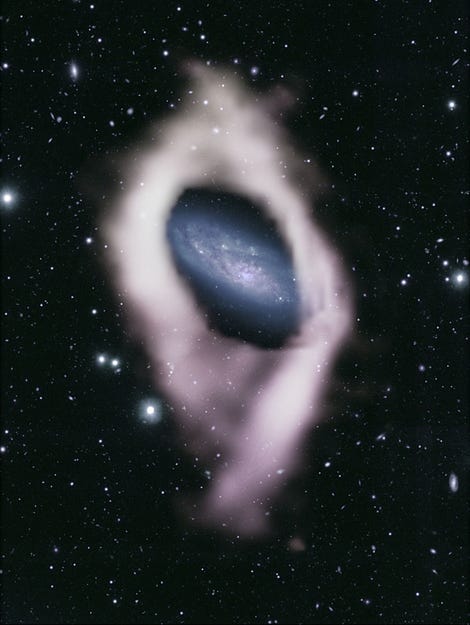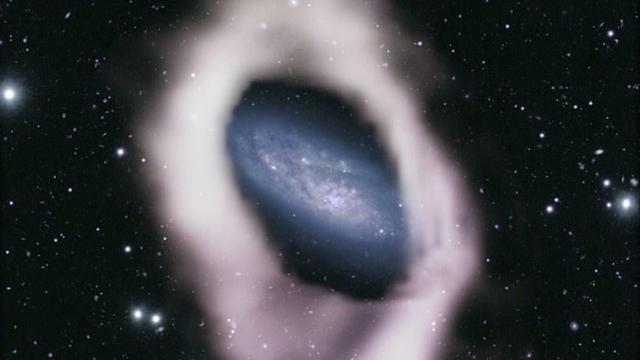A radio telescope in Australia recently captured a stunning image of NGC 4632, a galaxy some 56 million light-years from Earth. The image reveals a halo of cool hydrogen orbiting perpendicular to the galaxy itself.
This ring—a “polar ring”—makes NGC 4632 a polar ring galaxy. The hydrogen gas encircling the galaxy is invisible to optical telescopes, but proved no problem for CSIRO’s ASKAP radio telescope, which sits on Wajarri Yamaji Country in Western Australia. The image above is a composite, produced from a combination of ASKAP data of the gaseous ring and optical data from the Subaru telescope in Hawaii.
The potential polar ring was identified as part of the WALLABY pilot survey’s first data release. The team’s research describing the findings were published today in the Monthly Notices of the Royal Astronomical Society.

“The findings suggest that one to three per cent of nearby galaxies may have gaseous polar rings, which is much higher than suggested by optical telescopes,” said Nathan Deg, an astronomer at Queen’s University in Canada and the study’s lead author, in a CSIRO release. “Polar ring galaxies might be more common than previously thought.”
Polar rings may come about in a couple of ways. One theory is that the rings form from material accreted to the galaxy by another galaxy passing nearby. The material is then shredded up, giving the blend of gas, dust, and stellar material its opaque, amorphous look. Another theory is that hydrogen gas travels along cosmic web filaments and ends up forming star-studded rings around nearby galaxies, in this case NGC 4632.
The WALLABY survey (short for the Widefield ASKAP L-band Legacy All-sky Blind surveY) (and also that cute little guy) aims to image the entirety of the southern sky and visualize the gas distribution across hundreds of thousands of galaxies. So far the team has detected two apparent polar ring galaxies—NGC 4632 and NGC 6156—out of 600 galaxies observed so far.
“Using ASKAP over coming years we expect to reveal more than 200,000 hydrogen-rich galaxies, among them many more unusual galaxies like these ones with polar rings,” said Bärbel Koribalski, an astronomer at CSIRO and co-author of the new research, in the same release.
Though the data suggested that two of the galaxies seen by WALLABY have polar rings, they “do not definitively prove” that fact, the researchers wrote. As the survey proceeds, the team will get data on more galaxies that will clarify the frequency of polar rings around galaxies, and could even shed light on the shape and distribution of dark matter in galaxies.
ASKAP is the precursor to the intercontinental Square Kilometer Array (SKA), which will study the universe’s Epoch of Reionization. Construction on the SKA began in December 2022, but don’t hold your breath; the array’s construction is expected to be completed in 2028, and nothing slips in astronomy like a timeline.
